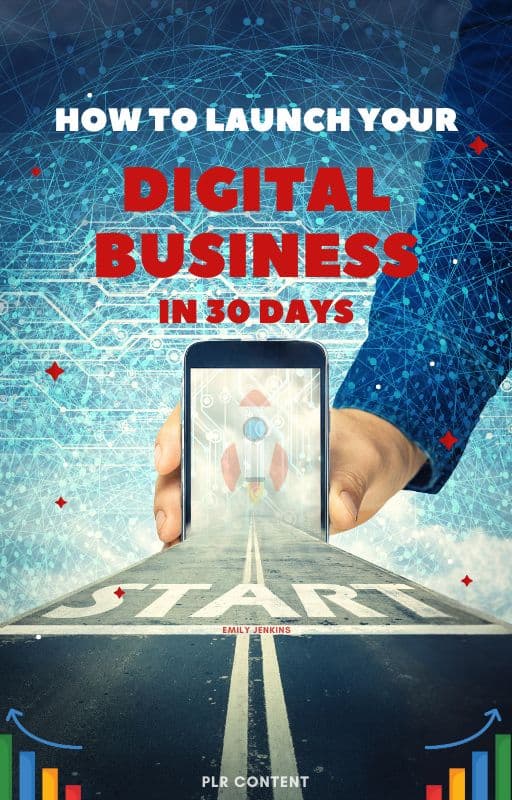You can contact us hereContact Us
The best discounts this week
Every week you can find the best discounts here.
Manifestation PLR eBook How to Manifest Exactly What You Want
PLR E-book – Launch Your Digital Business in 30 Days
PLR E-book – Social Media Success Secrets
Personal Growth PLR E-book: Unlock Your Potential
Faceless Marketing PLR E-book: Build a Profitable Brand with Resell Rights
Pre-Written SEO Blog Post – Spaghetti with Lemon-Garlic Parmesan Sauce
How to Earn Passive Income with Digital Products
Table of Contents
Passive Income with Digital Products
Passive income is a dream for many, a steady stream of earnings without the grind of a 9-to-5 job. One of the most effective and scalable ways to achieve this dream is through passive income with digital products. With minimal upfront costs and the ability to sell globally, digital products have revolutionized how people earn money online.
In this blog, we’ll explore how you can create and sell digital products to generate passive income, breaking down actionable strategies, best practices, and proven ideas. Whether you’re a seasoned entrepreneur or just starting your passive income journey, this guide will help you unlock the potential of digital products.
What Are Digital Products?
Digital products are intangible items that can be created, sold, and consumed entirely online, making them an excellent option for anyone looking to generate passive income with digital products. Unlike physical goods, they require no inventory, shipping, or manufacturing costs, making them a cost-effective and scalable income source. Examples include eBooks, Canva templates, stock photos, online courses, and software.
Why are digital products perfect for passive income? Once you create the product, it can be sold repeatedly with little ongoing effort. This scalability means you can continue earning long after the initial work is done. Platforms like Etsy, Gumroad, and personal websites make it easy to distribute these products to a global audience.
Digital products also offer creative freedom. Whether you’re a designer, educator, or writer, you can turn your skills into a valuable product that earns you money while you sleep.
Why Digital Products Are Ideal for Passive Income
When it comes to creating passive income with digital products, this approach is a true game-changer. Unlike physical goods, which require production, shipping, and inventory management, digital products are entirely virtual. This means they can be sold repeatedly with little to no additional effort once created. Plus, the startup costs are significantly lower compared to traditional businesses.
Think about it: a well-crafted e-book, an online course, or a set of digital templates can generate income for months—or even years—without ongoing input. This scalability makes digital products the perfect choice for anyone looking to diversify their income streams while minimizing the time spent on day-to-day operations.
Another advantage? The global reach. With the internet, your products can be accessible to customers worldwide, 24/7. Platforms like Etsy, Gumroad, and your own website make it easy to market and sell your creations to an audience that spans continents. This opens up opportunities for earning potential that far exceed what you might achieve with a local, physical business.
But the cherry on top is the creative freedom. Whether you’re a graphic designer, writer, educator, or hobbyist, digital products allow you to turn your expertise or passion into something valuable. And once your product is out there, automation tools handle the rest—giving you more time to focus on other priorities.
By building a portfolio of digital products, you’re not just creating income—you’re creating a legacy. A carefully curated collection can become your financial safety net, earning you money while you sleep. It’s the ultimate form of passive income.
Top Digital Products for Generating Passive Income with Digital Products
One of the greatest advantages of earning passive income with digital products is the sheer variety of options available. No matter your skills or expertise, there’s likely a digital product you can create and sell. Here are some of the most popular types to consider:
1. E-books
EBooks remain a versatile choice for creators looking to generate passive income with digital products by sharing their expertise. Whether it’s a guide on productivity hacks, a how-to manual for starting a small business, or a cookbook filled with healthy recipes, e-books can cater to virtually any audience. Platforms like Amazon Kindle Direct Publishing (KDP) make it easy to publish and distribute your work to millions of readers.
2. Canva Templates
Designers and content creators can create editable Canva templates for resumes, social media posts, or business presentations. These templates save time for buyers while providing you with a scalable product. They’re especially popular among small business owners and freelancers.
3. Online Courses
Share your expertise by creating an online course. Whether it’s teaching graphic design, social media marketing, or cooking, platforms like Teachable and Udemy allow you to package your knowledge into a high-value product.
4. Printables
Printables, such as planners, calendars, or goal-setting worksheets, are a low-cost digital product that appeals to a broad audience. These are perfect for creative entrepreneurs looking to sell on Etsy or their own website.
5. PLR Content
Private Label Rights (PLR) content allows buyers to rebrand and use it as their own. Pre-written blogs, social media captions, or e-books make PLR content a favorite for busy entrepreneurs.
6. Digital Art and Stock Photos
If you’re a photographer or artist, consider selling digital downloads of your work. Platforms like Shutterstock and Adobe Stock provide a marketplace for stock photos and illustrations.
7. Membership Content
Create a subscription-based membership site offering exclusive access to templates, guides, or tutorials. Memberships generate recurring revenue, making them a top-tier digital product for passive income.
8. Audio Files and Music
For musicians and podcasters, licensing audio tracks or selling sound effects can be an excellent revenue stream. Websites like AudioJungle cater to buyers seeking high-quality sound files.
Each of these options aligns with the flexibility and scalability that make digital products ideal for passive income. The key is to identify what aligns best with your skillset and audience needs.
How to Create High-Quality Digital Products
The quality of your digital products plays a significant role in determining your success in earning passive income with digital products. Here’s a step-by-step guide to creating products that stand out:
1. Identify Your Niche and Audience
Before creating a digital product, research your target audience. What are their needs, pain points, and preferences? Focus on a specific niche where your expertise shines. For instance:
- Graphic designers can create Canva templates.
- Writers can sell eBooks or PLR content.
- Educators can launch online courses or printables.
2. Choose the Right Format
Select a format that aligns with your skills and appeals to your audience. Popular options include:
- EBooks for knowledge sharing.
- Online courses for in-depth learning.
- Templates for quick, ready-to-use solutions.
- Printables for goal-setting, planners, or educational tools.
3. Leverage the Best Tools
Use tools like Canva, Adobe Creative Suite, or specialized platforms like Thinkific or Teachable to design and build your products. These tools offer user-friendly interfaces and professional-grade features to create polished digital assets.
4. Focus on Quality and Value
Your product should deliver value that exceeds customer expectations. Keep these tips in mind:
- Use high-quality visuals and professional designs.
- Provide actionable, step-by-step guides or instructions.
- Ensure easy-to-use, editable formats for templates and planners.
5. Test and Refine Your Product
Before launching, test your product with a small group of users for feedback. Address issues related to usability, design, or clarity. A polished product is more likely to generate positive reviews and repeat customers.
6. Add Branding and Personalization
Incorporate your logo, color scheme, and unique style into your products. For instance, include editable fields in Canva templates or customize printables with themes that resonate with your audience.
7. Bundle Products for Increased Value
To boost sales, consider creating bundles of related products. For example:
- A bundle of social media templates for various industries.
- A complete set of productivity planners and goal-setting worksheets.
Bundling not only increases perceived value but also encourages customers to spend more.
8. Ensure SEO Optimization for Online Products
If you’re selling through your website, optimize product descriptions, titles, and images with SEO keywords like “passive income with digital products.” This ensures better visibility on search engines.
9. Utilize Mockups for Presentation
Showcase your digital products with professional mockups to give customers a clear idea of what they’re purchasing. Platforms like Canva offer ready-to-use mockup templates.
10. Set Competitive Pricing
Research your competitors to set competitive yet profitable prices. Don’t undervalue your work—emphasize the benefits and unique selling points of your product.
By focusing on quality, presentation, and audience needs, you can create digital products that generate consistent passive income while building a loyal customer base.
Platforms to Sell Digital Products
Choosing the right platform to sell your digital products is crucial for reaching your target audience and maximizing passive income with digital products. Here are some of the best platforms, along with their pros and cons:
1. Your Website
Building your own website gives you complete control over branding, pricing, and customer experience. Platforms like WordPress with WooCommerce or Shopify make it easy to set up an e-commerce store.
- Pros:
- Full control over your business.
- No marketplace fees.
- Build your brand authority.
- Cons:
- Requires upfront investment and technical skills.
- Driving traffic relies heavily on SEO and marketing efforts.
2. Etsy
Etsy is a popular marketplace for creative goods, including digital products like templates, printables, and planners.
- Pros:
- High visibility and an established customer base.
- Easy setup with no need for a website.
- Cons:
- Competitive market with many sellers.
- Marketplace fees and commission rates.
3. Gumroad
Gumroad is a simple platform for selling digital products, ideal for beginners.
- Pros:
- Easy to use, even for non-tech-savvy creators.
- Flexible pricing options and built-in analytics.
- Cons:
- Limited design customization for storefronts.
- Transaction fees can add up.
4. Amazon Kindle Direct Publishing (KDP)
For authors, KDP is the go-to platform to publish and sell eBooks.
- Pros:
- Access to a massive global audience.
- Passive income through royalties.
- Cons:
- Highly competitive market.
- Limited control over pricing and design.
5. Teachable and Thinkific
For online courses, platforms like Teachable and Thinkific are excellent choices.
- Pros:
- Easy-to-use course creation tools.
- Host and market your courses on a single platform.
- Cons:
- Monthly subscription fees.
- Limited customization options.
6. Creative Market
Creative Market specializes in design assets like templates, fonts, and stock photos.
- Pros:
- Targeted audience for creative products.
- No exclusivity required—sell elsewhere too.
- Cons:
- Competitive with high commission rates.
7. Social Media Platforms
Social media platforms like Instagram, Pinterest, and TikTok can also serve as sales channels when paired with tools like Linktree or direct messaging.
- Pros:
- Direct engagement with your audience.
- Free to use for promotion.
- Cons:
- Not ideal for hosting or managing large-scale sales.
Each platform offers unique advantages depending on the type of digital product and your business goals. To maximize your earnings, consider combining a few platforms for a broader reach while maintaining control over your brand.
Marketing Your Digital Products Effectively
Creating high-quality digital products is just one part of the equation. To earn passive income with digital products, you need a well-thought-out marketing strategy that puts your creations in front of the right audience. Here are proven techniques to help you market your digital products effectively:
1. Leverage SEO
Search engine optimization (SEO) is essential for driving organic traffic to your product pages.
- Conduct keyword research to identify what your audience is searching for.
- Optimize your product descriptions, blog posts, and website content with keywords like “passive income with digital products.”
- Use metadata, alt text for images, and internal links to improve your ranking on search engines.
2. Utilize Social Media Marketing
Social media platforms like Instagram, Pinterest, and TikTok are powerful tools for promoting digital products.
- Create visually appealing posts showcasing your products in action.
- Use relevant hashtags to increase discoverability.
- Engage with your audience through stories, reels, and comments.
Pro Tip: Platforms like Canva make it easy to design stunning visuals that grab attention.
3. Build an Email List
Email marketing remains one of the most effective ways to connect with potential buyers.
- Offer a freebie, like a sample template or mini eBook, in exchange for email sign-ups.
- Send regular newsletters with product updates, promotions, and tips related to your niche.
- Use personalized subject lines to improve open rates.
4. Collaborate with Influencers
Partnering with influencers in your niche can give your products significant visibility.
- Choose influencers whose audience aligns with your target market.
- Offer them free products in exchange for a review or promotion.
- Track engagement and conversions from influencer campaigns to measure ROI.
5. Invest in Paid Advertising
If your budget allows, consider running paid ads on platforms like Google Ads, Facebook, or Pinterest.
- Target specific demographics and interests to ensure your ads reach the right audience.
- A/B test ad designs and copy to optimize performance.
Pro Tip: Start with a small budget and scale up based on results.
6. Showcase Testimonials and Reviews
Social proof builds trust and encourages potential buyers to make a purchase.
- Highlight customer testimonials on your website and social media.
- Ask satisfied customers to leave reviews or share their experiences.
7. Create Free Content to Build Authority
Blog posts, YouTube tutorials, and downloadable resources can position you as an expert in your field while driving traffic to your products.
- Write blogs that address common problems your audience faces.
- Include CTAs linking to your digital products.
Effective marketing isn’t just about getting eyes on your products; it’s about building relationships and trust with your audience. By combining these strategies, you’ll not only increase your product visibility but also establish your brand as a go-to resource for high-quality digital products.
Scaling Your Digital Product Business
Once you’ve successfully launched your first few digital products and started earning passive income with digital products, the next step is to scale your business. Scaling doesn’t just mean creating more products—it’s about strategically growing your income streams and maximizing the potential of your existing products. Here’s how to do it:
1. Create Bundles and Upsells
Bundling related digital products can significantly increase the perceived value and encourage customers to spend more.
- Example: Combine social media templates, a content planner, and a branding guide into a single package.
- Add upsells by offering premium features or extended usage rights for an additional cost.
Pro Tip: Position bundles as limited-time offers to create urgency.
2. Automate Your Sales and Marketing
Automation tools can help you scale without overwhelming your time and resources.
- Use platforms like Shopify or WooCommerce to handle payments and product delivery seamlessly.
- Set up automated email sequences to nurture leads and promote new products.
- Use social media scheduling tools to maintain consistent visibility.
3. Expand Your Product Line
Diversify your offerings to cater to different audience needs and preferences.
- Add new templates, eBooks, or courses that complement your existing products.
- Offer products in different formats, such as video tutorials or audio guides, to reach a broader audience.
4. Explore New Platforms
If you’ve been focusing on one platform, consider expanding to others to reach a larger audience.
- For example, if you sell on Etsy, try adding your products to Gumroad or your website.
- Use marketplaces like Creative Market or Amazon KDP to target specific niches.
5. Use Analytics to Optimize Performance
Leverage analytics to understand what’s working and where you can improve.
- Track metrics like conversion rates, traffic sources, and customer behavior.
- Double down on products and marketing channels that perform well.
- Regularly update and improve your best-selling products based on customer feedback.
6. Build a Membership Model
Recurring revenue is a powerful way to scale your income. Create a membership site that offers exclusive access to digital products, updates, and resources.
- Example: A subscription that provides monthly Canva template bundles for small business owners.
Pro Tip: Regularly add new content to keep subscribers engaged and reduce churn.
7. Collaborate with Other Creators
Partnering with other digital product creators can help you expand your audience and product offerings.
- Co-create bundles with complementary creators.
- Cross-promote products through email lists or social media collaborations.
8. Invest in Paid Growth Strategies
When your revenue allows, invest in paid advertising or hire a marketing expert to amplify your reach.
- Use targeted ads on platforms like Google, Facebook, and Instagram.
- Retarget website visitors to increase conversions.
Scaling a digital product business is about working smarter, not harder. By optimizing your processes, diversifying your offerings, and leveraging tools and collaborations, you can grow your business while maintaining the passive income model.
Common Mistakes to Avoid When Selling Digital Products
While selling digital products is a lucrative way to generate passive income, it’s not without its challenges. Many creators stumble into common pitfalls that hinder their success. Here are the top mistakes to avoid when selling digital products and how to address them:
1. Neglecting Market Research
Jumping into product creation without understanding your audience’s needs can lead to a product no one wants to buy.
- Solution: Spend time researching your target audience and identify their pain points. Use tools like Google Trends, SEMrush, or surveys to gauge demand before investing in a product idea.
2. Overlooking Quality
Rushing through product creation often results in low-quality offerings that fail to meet customer expectations.
- Solution: Focus on delivering value with well-designed, polished, and easy-to-use digital products. Proofread eBooks, test templates, and gather feedback from beta users before launching.
3. Weak Product Descriptions
Even a high-quality product will struggle to sell without a compelling description.
- Solution: Write detailed, benefit-driven descriptions. Highlight how your product solves a problem or improves the buyer’s life. Optimize descriptions with keywords like “passive income with digital products” for SEO.
4. Ignoring SEO and Marketing
Simply listing your digital product on a platform isn’t enough to drive sales. Without marketing, your product may go unnoticed.
- Solution: Develop a marketing strategy that includes SEO, social media promotion, and email campaigns. Use platforms like Pinterest and Instagram to showcase your products with eye-catching visuals.
5. Setting Unrealistic Prices
Pricing too high can deter buyers, while pricing too low undervalues your work and limits profitability.
- Solution: Research competitors to determine fair pricing. Experiment with pricing strategies, such as offering bundles or limited-time discounts, to maximize sales.
6. Failing to Build an Audience
Relying solely on marketplaces like Etsy or Gumroad without nurturing a dedicated audience can limit your growth.
- Solution: Build an email list, engage with followers on social media, and establish a strong personal brand to create a loyal customer base.
7. Poor Customer Support
Even with digital products, buyers may have questions or need assistance. Ignoring customer inquiries can lead to negative reviews.
- Solution: Offer responsive and professional customer support. Create an FAQ section for common questions and provide clear instructions with your products.
8. Not Updating Products Regularly
Digital products can become outdated quickly, especially in niches like design or marketing.
- Solution: Periodically update your products to maintain relevance. For example, refresh Canva templates with current design trends or revise eBooks with updated information.
9. Skipping Automation Opportunities
Manually handling orders, payments, and delivery can overwhelm you as your sales grow.
- Solution: Automate processes using tools like Shopify or WooCommerce. Automation ensures a seamless experience for buyers and saves you time.
10. Lacking a Clear Call-to-Action (CTA)
Your product pages and marketing materials need strong CTAs to convert visitors into buyers.
- Solution: Use CTAs like “Download Now,” “Get Instant Access,” or “Start Earning Today” to guide customers to take action.
Avoiding these common mistakes can set you up for long-term success in earning passive income with digital products. By focusing on quality, strategy, and audience engagement, you’ll position yourself as a trusted creator in the digital marketplace.
The Future of Passive Income with Digital Products
As technology continues to evolve and the global demand for online content grows, the future of earning passive income with digital products looks brighter than ever. Digital products offer an unparalleled opportunity to create scalable, sustainable passive income with digital products, making them the future of online business. Here’s what the future holds and why now is the perfect time to get started:
1. Rising Demand for Digital Solutions
From businesses seeking efficient tools to individuals looking for educational resources, the demand for high-quality digital products is expected to grow exponentially. Remote work trends, online learning, and the rise of e-commerce have all contributed to this surge.
- Opportunities: Online courses, productivity templates, and membership sites are projected to be among the top-selling categories.
2. Advanced Tools and Automation
New tools and platforms are continuously emerging, making it easier for creators to design, market, and sell their digital products. Advanced AI tools can now assist with content creation, while platforms like Shopify and Gumroad continue to enhance automation for seamless product delivery.
- Pro Tip: Use tools like Canva for easy product creation and Rank Math for optimizing your product pages for SEO.
3. Expanding Global Reach
The internet has made it possible to sell digital products to anyone, anywhere, 24/7. With increased internet penetration globally, creators can now tap into international markets and reach untapped audiences.
- Opportunities: Offer products in multiple languages or cater to niche global markets for greater reach.
4. Creative Freedom and Flexibility
Digital products empower creators to monetize their passions and skills without being tied to a traditional office or physical inventory. The low barriers to entry mean anyone with an idea and determination can participate in this growing market.
5. Sustainability and Scalability
Unlike physical products, digital products align with sustainability goals. There’s no waste, no shipping, and minimal energy consumption involved in their creation and delivery. This makes them an eco-friendly choice for conscious consumers and creators alike.
Why You Should Start Today
The key to success in this ever-expanding market is to act now. By building your portfolio of digital products today, you’ll not only start generating passive income but also secure your place in a competitive yet rewarding industry.
At Contentlicious, we provide the tools and resources to help you thrive. Whether it’s Canva templates, PLR content, or guides to kickstart your journey, we’re here to make earning passive income with digital products accessible and achievable.
👉 Ready to create your first passive income stream?
- Explore our Canva Templates to start designing professional digital products.
- Browse our shop to jumpstart your product line with pre-written materials.
- Need help? Check out our guides and resources tailored for aspiring entrepreneurs like you.
Start today, and watch your passive income journey unfold… one step at a time!
Subscribe to Our Newsletter
Limited-Time Offers: Grab These Discounts!
-
 Manifestation PLR eBook How to Manifest Exactly What You Want
Manifestation PLR eBook How to Manifest Exactly What You Want
$29.99Original price was: $29.99.$8.00Current price is: $8.00. -
PLR E-book - Launch Your Digital Business in 30 Days
$9.99Original price was: $9.99.$2.99Current price is: $2.99. -
PLR E-book - Social Media Success Secrets
$9.99Original price was: $9.99.$4.99Current price is: $4.99. -
Personal Growth PLR E-book: Unlock Your Potential
$29.99Original price was: $29.99.$14.99Current price is: $14.99. -
Faceless Marketing PLR E-book: Build a Profitable Brand with Resell Rights
$14.99Original price was: $14.99.$9.99Current price is: $9.99.
















